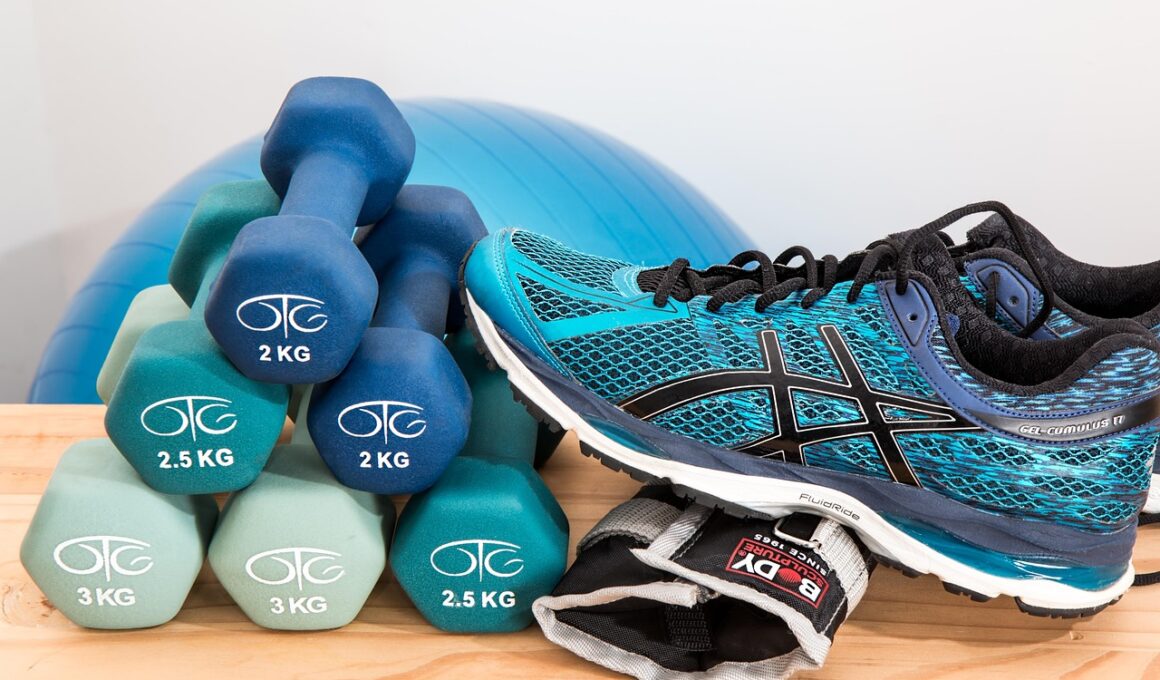Optimizing Athletic Training Through Biomechanical Assessment
Biomechanical assessment is pivotal in enhancing athletic performance and mitigating injuries in sports. By analyzing movement mechanics, coaches and athletes gain valuable insights, leading to informed training strategies. Utilizing technologies such as 3D motion capture, force plates, and wearable sensors provides precise data on biomechanics. This data aids in understanding an athlete’s posture, force application, and overall efficiency. Consequently, athletes can tailor their training regimens according to individual assessments, ensuring they are targeting areas needing improvement. Furthermore, biomechanical evaluations help identify overuse injuries by monitoring joint angles and movement patterns, ensuring athletes do not push their limits carelessly. Emphasizing the importance of individualized training can lead to noteworthy improvements in performance and reductions in injury rates. The human body’s complex interactions during physical activity necessitate a comprehensive approach for optimal results. Collaboration among sports scientists, coaches, and athletes is essential for effective implementation of biomechanical assessments. Integrating these insights into training planning can revolutionize athlete preparation, leading to success in competitive environments. Ultimately, adopting these methodologies positions teams and individual athletes for enhanced performance while fostering long-term athletic health.
Continuing with the significance of biomechanical assessment, athletes should engage in routine evaluations to monitor progress. Regular assessments play a crucial role, allowing for adjusting training intensity and techniques accordingly. Implementing protocols for periodic reviews aids in determining trends in performance, essential for setting realistic goals. As progress is documented over time using biomechanical metrics, athletes develop a better understanding of their bodies, fostering self-awareness during training. Evaluating specific movements, such as sprinting, jumping, or pivoting, uncovers vital insights into how forces are distributed through the body, providing opportunities for targeted interventions. Moreover, coaches can utilize this information to guide athletes toward achieving their performance objectives while emphasizing injury prevention. The feedback loop created from ongoing assessments enhances communication between athletes and coaching staff. This process fosters a healthy training environment where adjustments can be made proactively. Athletes, empowered by understanding their biomechanics, can actively participate in the optimization of their training. These insights allow for educated decisions about their training schedules and approaches. Ultimately, incorporating biomechanical assessments consistently sets the foundation for sustained performance growth and improvement across all athletic levels.
The Role of Technology in Biomechanical Assessment
Advancements in technology have transformed biomechanical assessments, offering unprecedented accuracy and efficiency regarding data collection. Devices like accelerometers and gyroscopes can capture intricate details on movement patterns and dynamics, facilitating comprehensive analyses. These innovations enable professionals to assess not only the mechanics of movement but also the physiological responses during athletic performance. By collecting real-time data, coaches can provide immediate feedback to athletes, enhancing learning and strategy development. Furthermore, machine learning algorithms analyze vast amounts of biomechanical data to identify patterns and predict future performance outcomes, ultimately enabling tailored training solutions for athletes. The integration of mobile applications allows athletes to track their biomechanics remotely, encouraging accessibility for both recreational and elite athletes alike. Understanding an athlete’s biomechanics through these technological lenses creates a framework for significant performance improvement. Moreover, wearable technologies enhance the detection of fatigue levels, further assisting in optimizing training programs. These insights contribute to creating well-informed training plans focused on athlete well-being while achieving peak performance. The partnership of advanced technology and biomechanics leads to better-informed decisions, ultimately revolutionizing the landscape of athletic training and preparation throughout sport disciplines.
Furthermore, biomechanical assessments facilitate rehabilitation strategies for injured athletes seeking to return to their sports. During rehabilitation, monitoring movement mechanics enables therapists to track recovery progress accurately. Assessing an athlete’s functional movement patterns ensures that techniques and exercises align with their physiological capabilities and current state of healing. This precision reduces the risk of re-injury by ensuring a gradual, managed return to performance. Identifying faulty movement patterns that contributed to the injury during assessments enables therapists to develop targeted corrective exercises. Addressing these flaws proactively enhances the body’s resilience against future injuries, solidifying injury prevention measures. As athletes transition back into training, biomechanical monitoring plays a pivotal role in validating that they are performing safely and effectively. This also promotes athlete confidence during their return, which is crucial not only for performance but also for mental well-being. The combination of physical rehab strategies and biomechanical assessments create a holistic recovery process for injured athletes aimed at restoring peak performance without undue risk. Thus, adopting these monitoring strategies is essential in creating a seamless, scientific approach towards rehabilitation in sports and athletic training.
Customized Training Programs Based on Biomechanical Analysis
The insights gained from biomechanical assessments allow for the creation of customized training programs tailored to individual athletic profiles. By understanding each athlete’s unique movement patterns, strength, and weaknesses, trainers can design specific drills and interventions that focus on improving particular aspects of performance. Such customization not only enhances efficiency during training sessions but also fosters a sense of ownership and motivation in the athlete. Training regimens become far more targeted, addressing specific goals and challenges that athletes face. These individualized programs can incorporate various training modalities, such as strength training, flexibility, and agility work. Using these insights maximizes the athlete’s potential while minimizing injury risk. Additionally, such tailored plans encourage long-term adherence to training, as athletes witness tangible progress aligned with their personalized goals. The concept of one-size-fits-all is effectively replaced by holistic approaches considered individualized assessments across all levels of athletic performance. Consequently, those involved in designing training regimens must emphasize agility in adaptation as athletes progress, ensuring the training remains relevant and responsive to their evolving needs. This approach creates a dynamic training environment that nurtures sustained athletic growth.
Moreover, utilizing biomechanical assessments in team sports contributes to developing team strategies and formations. Coaches can analyze the biomechanics of individual players to understand collective dynamics during gameplay. This data-driven approach enables the formulation of tactics that leverage each player’s unique physical abilities and biomechanics for optimal performance. Examining how biomechanics influence player interactions on the field facilitates a significant competitive edge. Understanding spatial awareness, positioning, and movement efficiency allows coaches to establish effective game strategies that bring out the best in their teams. Employing data analytics enhances real-time tactical decisions, allowing for substitutions and adjustments based on biomechanical feedback. Cross-referencing player data with opponent analysis offers additional insights that can influence game strategies to counter their opponents. Integrating these biomechanical insights into team practice enables coaches to optimize collective performance, adapting drills to suit the physical capabilities of their roster. This holistic tactical development nurtures a winning team environment through improved performance synergy. Overall, adopting biomechanical assessments creates a foundation for integrating scientific methodology into team sports, unlocking new potential for success on the competitive stage.
The Future of Athletic Training and Biomechanics
As we advance further into the realm of athletic training, the role of biomechanical assessments will only continue to expand. Future developments in biomechanics may incorporate artificial intelligence and machine learning into assessing and planning athletic training programs. These innovations offer immense potential to analyze complex data sets efficiently while identifying correlations that human analysis might miss. The future of sports science will focus heavily on personalized and predictive training paradigms gained from biomechanical insights. Athletes and coaches will likely have more access to real-time data analysis platforms, enabling quick adjustments to training strategies. Such advancements facilitate ongoing motivation, enhance accountability, and maintain performance trajectories during training cycles. Moreover, the increasing emphasis on mental well-being among athletes is anticipated to incorporate more holistic approaches towards integrating biomechanics with psychological performance strategies. Considering mental health alongside physical assessments will promote athlete-centric training methodologies that ultimately tend toward higher competitive success. The evolution of athletic training through biomechanics promises exciting strategies and outcomes in the sports industry, ensuring informed athlete preparations and optimal performance on all levels.
In conclusion, biomechanical assessments serve as a foundational element in optimizing athletic training and performance outcomes. From initial assessments through the rehabilitation process, integrating biomechanics fosters a comprehensive understanding of an athlete’s capabilities and limits. Customized training programs crafted from biomechanical data empower athletes to reach their objectives while minimizing injury risk. The collaboration among technology, science, and trained professionals ensures athletes are equipped with the best available tools and resources during their training journeys. The benefits extend far beyond individual performance, resonating throughout teams and sporting organizations altogether. As the landscape of athletic training continues to evolve, remaining committed to integrating biomechanical assessments into standard practice is essential for achieving sustained success. The strategic adoption of biomechanical evaluation tools will not only enhance athletic performance but will fundamentally change how athletes and coaches approach training, recovery, and competition. Emphasizing long-term athlete health alongside performance will redefine success in sports, ensuring a holistic and sustainable pathway for all involved. In this manner, the field of exercise science, specifically kinesiology, will thrive through innovation, research, and practical applications dedicated to enhancing athletic excellence and well-being.


